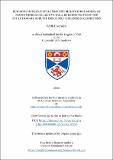Files in this item
Building models : developing the behavioural model of Temnothorax collective wall building to study the evolutionary robustness of self-organised algorithms
Item metadata
| dc.contributor.advisor | Ruxton, Graeme Douglas | |
| dc.contributor.advisor | Smith, V. Anne | |
| dc.contributor.author | Invernizzi, Edith | |
| dc.coverage.spatial | 170 | en_US |
| dc.date.accessioned | 2023-03-28T11:22:24Z | |
| dc.date.available | 2023-03-28T11:22:24Z | |
| dc.date.issued | 2022-11-29 | |
| dc.identifier.uri | https://hdl.handle.net/10023/27278 | |
| dc.description.abstract | This thesis focuses on wall building behaviour in Temnothorax ants as a case study of self-organised collective behaviour. It contains a progressing series of research packages, building towards one evolutionary question: how eusocial insect nest building algorithms successfully make the transition between two rule variants. I start by revising the existent behavioural model of Temnothorax wall building. By replicating the original agent-based model, I identify two issues: 1. the behavioural model performs poorly in conditions of low building material availability; and 2. the behavioural model lacks behavioural termination. I then introduce a revised version of the behavioural model (the gradual model) in which high stone density at building sites triggers a decrease in building activity, eventually leading to behavioural termination. I then compare the fit of both models to empirical data using laboratory observations of T. rugatulus wall building, applying a hidden Markov model framework to interpret the data. The gradual model provides the best match to the observed data. Finally, I use the revised model to test, in an agent-based model setting, how wall quality responds to different types of inter-worker variation in the building rule used: the presence of a mutant variant spreading within the colony; the co-existence of multiple variants; and widespread epigenetic individual variation. I find wall quality to be very robust to nearly any degree and frequency of variants. With additional simulations, I identify the two key elements of the building algorithm that provide robustness: the positive feedback effect, co-localising worker effort despite starting individual variation; and the existence of an area of overlap where activity occurs with high frequency under all variants (a buffer zone). I predict that these two components have been under selection for evolvability in wall building Temnothorax ants. | en_US |
| dc.description.sponsorship | "This work was supported by the John Templeton Foundation as part of the research programme 'Putting the Extended Evolutionary Synthesis to the test' [grant number 60501]. EI’s training and conference travels were partially supported by the Santander-St Leonard’s College Research Mobility Scholarship and by the Sir Ken Murray Endowment Fund." --Funding | en |
| dc.language.iso | en | en_US |
| dc.relation | Building models: Developing the behavioural model of Temnothorax collective wall building to study the evolutionary robustness of self-organised algorithms (dataset) Invernizzi, E., University of St Andrews, GitHub, 2022. URL: https://github.com/invernie/PhD-thesis | |
| dc.relation.uri | https://github.com/invernie/PhD-thesis | en |
| dc.rights | Creative Commons Attribution-NoDerivatives 4.0 International | * |
| dc.rights.uri | http://creativecommons.org/licenses/by-nd/4.0/ | * |
| dc.subject | Group behaviour | en_US |
| dc.subject | Self-organisation | en_US |
| dc.subject | Ant | en_US |
| dc.subject | Temnothorax | en_US |
| dc.subject | Nest building | en_US |
| dc.subject | Evolution | en_US |
| dc.subject | Evolution of collective behaviour | en_US |
| dc.subject | Evolution and self-organisation | en_US |
| dc.title | Building models : developing the behavioural model of Temnothorax collective wall building to study the evolutionary robustness of self-organised algorithms | en_US |
| dc.type | Thesis | en_US |
| dc.contributor.sponsor | Templeton Foundation | en_US |
| dc.type.qualificationlevel | Doctoral | en_US |
| dc.type.qualificationname | PhD Doctor of Philosophy | en_US |
| dc.publisher.institution | The University of St Andrews | en_US |
| dc.identifier.doi | https://doi.org/10.17630/sta/374 | |
| dc.identifier.grantnumber | 60501 | en_US |
The following licence files are associated with this item:
This item appears in the following Collection(s)
Except where otherwise noted within the work, this item's licence for re-use is described as Creative Commons Attribution-NoDerivatives 4.0 International
Items in the St Andrews Research Repository are protected by copyright, with all rights reserved, unless otherwise indicated.


